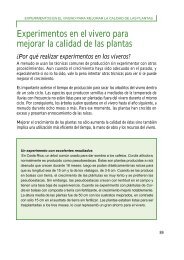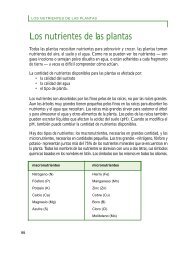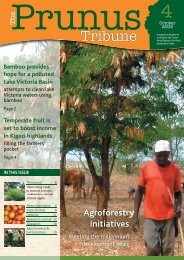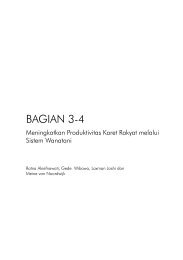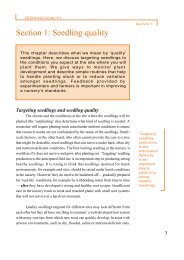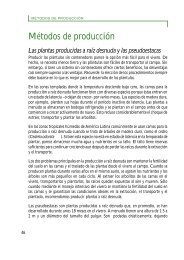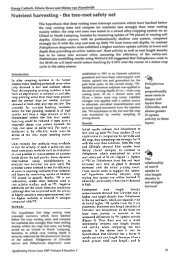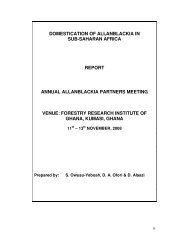Section 5: Nursery and plant hygiene - World Agroforestry Centre
Section 5: Nursery and plant hygiene - World Agroforestry Centre
Section 5: Nursery and plant hygiene - World Agroforestry Centre
You also want an ePaper? Increase the reach of your titles
YUMPU automatically turns print PDFs into web optimized ePapers that Google loves.
NURSERY AND PLANT HYGIENE• propagation substrates• irrigation water• <strong>plant</strong>ing stock: seeds, cuttings, scions <strong>and</strong> rootstocks• shoes <strong>and</strong> clothing of nursery staff <strong>and</strong> visitors.Plant <strong>hygiene</strong> begins before propagation, by paying attention to these five entrypoints.Propagation facilities• Keep the nursery area itself free of weeds. Many <strong>plant</strong> species can bealternate hosts of important nursery pests. This precaution includes asensible selection of ornamentals, shade, hedge <strong>and</strong> windbreak <strong>plant</strong>s in<strong>and</strong> around the nursery, as they too can be hosts for pests such as nematodes.• Treat all wooden supports with old engine oil or chemicals against termiteattack. If possible, place propagation structures onto a slab of concrete.• Keep tools, work surfaces <strong>and</strong> containers clean at all times. Take particularcare with proper sterilization of containers, especially when these arereusable ones. Root diseases such as Fusarium root rot can be transmittedthrough diseased root segments grown into the wall of styrofoam containers.Some tools <strong>and</strong> containers can be autoclaved but the necessary equipmentis not always available.<strong>Section</strong> 5Keep thenurseryarea freeof weeds<strong>and</strong> keeptools, worksurfaces<strong>and</strong> containersclean atall times.One of the most satisfactory <strong>and</strong> readily available chemicals forsterilizing nursery equipment is chlorine, the active ingredient of householdbleach. Chlorine is a very irritating gas with a pungent odour. It evaporateseasily <strong>and</strong> its smell can be detected in very low concentrations (0.2–0.4 ppm);in higher concentrations it irritates eyes, nose <strong>and</strong> throat. It is a strong oxidizingagent <strong>and</strong> kills organisms by chemically ‘burning’ their tissue. It is usuallydiluted in water. The usual form of chlorine in household bleach is as the sodiumsalt, sodium hypochlorite (NaOCl). Commercial household bleach contains3.5% NaOCl in water. To use it as a sterilant, make a 10% solution (1 partbleach to 9 parts water) <strong>and</strong> soak instruments or containers in it for at least 30minutes. The use of a few drops of washing up liquid helps prevent air bubblesnext to the surface. Chlorine is deactivated by dirt particles. Therefore cleanall material to be sterilized thoroughly before putting it into the solution. Makea fresh solution each time you need it, <strong>and</strong> replace when dirty.57






